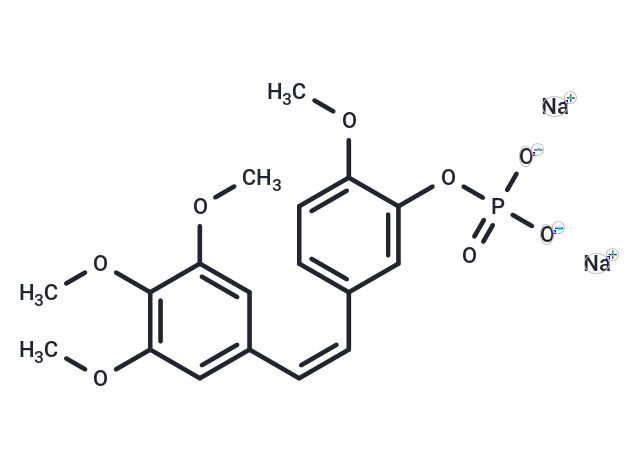Shopping Cart
- Remove All
 Your shopping cart is currently empty
Your shopping cart is currently empty

Fosbretabulin Disodium (CA 4P), a water-soluble prodrug of Combretastatin A4 (CA4), is a microtubule-targeting agent that binds β-tubulin (Kd: 0.4 μM). Fosbretabulin Disodium(Combretastatin A4 disodium phosphate) inhibits the polymerization of tubulin (IC50: 2.4 μM), and also disrupts tumor vasculature.

| Pack Size | Price | Availability | Quantity |
|---|---|---|---|
| 1 mg | $32 | In Stock | |
| 2 mg | $45 | In Stock | |
| 5 mg | $72 | In Stock | |
| 10 mg | $97 | In Stock | |
| 25 mg | $173 | In Stock | |
| 50 mg | $288 | In Stock | |
| 100 mg | $369 | In Stock |
| Description | Fosbretabulin Disodium (CA 4P), a water-soluble prodrug of Combretastatin A4 (CA4), is a microtubule-targeting agent that binds β-tubulin (Kd: 0.4 μM). Fosbretabulin Disodium(Combretastatin A4 disodium phosphate) inhibits the polymerization of tubulin (IC50: 2.4 μM), and also disrupts tumor vasculature. |
| Targets&IC50 | Tubulin:2.4 μM |
| In vitro | Fosbretabulin disodium (Combretastatin A-4 phosphate disodium, CA4P disodium) is the water-soluble prodrug of combretastatin A4 (CA4), which is originally isolated from African tree Combretum caffrum. CA4 is a tubulin-binding agent that binds at or near the colchicine binding site of β-tubulin (Kd = 0.40 μM), inhibits tubulin assembly with IC50 of 2.4 μM. [1] CA4 is cytotoxic towards proliferating but not quiescent endothelial cells, has potent and selective toxicity towards tumor vasculature. [2] CA4P (1 mM, 30 minutes) disrupts the endothelial microtubule cytoskeleton and mediates changes in endothelial cell morphology. CA4P stimulates actin stress fiber formation and membrane blebbing and increases monolayer permeability via Rho/Rho-kinase. [3] CA4P increases endothelial cell permeability, while inhibiting endothelial cell migration and capillary tube formation predominantly through disruption of VE-cadherin/β-catenin/Akt signaling pathway, thereby leading to rapid vascular collapse and tumor necrosis. [4] |
| In vivo | CA4P causes rapid, extensive and irreversible vascular shutdown in experimental tumor models following the administration of a single dose at 10% of the maximum tolerated dose (MTD). CA4P causes a 93% reduction in vascular volume 6 h following drug administration. [2] CA4P(100 mg/kg, 6 h following administration) reduces tumor blood by approximately 100-fold, compared with approximately 7-fold in the spleen. [5] |
| Kinase Assay | Tubulin assembly-disassembly: The assembly of microtubules from isolated tubulin is carried out spectrophotometrically at 350 nm and utilises the increase in turbidity which is associated with microtubule formation. Assembly is initiated by temperature increase from 10 to 35 °C. The effect of drugs on the increase in light absorption is carried. Drugs are dissolved in DMSO (<4%), which does not affect control assembly |
| Cell Research | For the proliferation assay, the minimal concentration of FBS (1%) diluted in X-VIVO medium is used to allow sufficient viability of endothelial cells. After detachment, the cells are seeded at a concentration of 2×104 HUVECs in each well of 24-well plates, allowed to adhere overnight, and then incubated with or without cytokines (5 ng/ml FGF-2 or 5 ng/ml VEGF-A). CA4P is added at 0 – 50 nM. After incubation for 12, 24, 36, and 48 hours, cells are detached by trypsin/EDTA and manually counted using trypan blue exclusion. (Only for Reference) |
| Alias | Fosbretabulin (Combretastatin A4 Phosphate (CA4P)) Disodium, Combretastatin A4 Phosphate, Combretastatin A4 disodium phosphate, CA 4P, CA 4DP |
| Molecular Weight | 440.29 |
| Formula | C18H19O8P·2Na |
| Cas No. | 168555-66-6 |
| Smiles | [Na+].[Na+].COc1ccc(\C=C/c2cc(OC)c(OC)c(OC)c2)cc1OP([O-])([O-])=O |
| Relative Density. | no data available |
| Storage | store at low temperature | Powder: -20°C for 3 years | In solvent: -80°C for 1 year | Shipping with blue ice. | ||||||||||||||||||||
| Solubility Information | H2O: 10 mM, Sonication is recommended. DMSO: Insoluble | ||||||||||||||||||||
Solution Preparation Table | |||||||||||||||||||||
H2O
| |||||||||||||||||||||

Copyright © 2015-2024 TargetMol Chemicals Inc. All Rights Reserved.